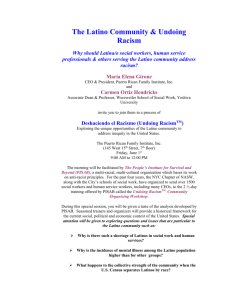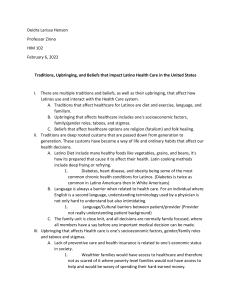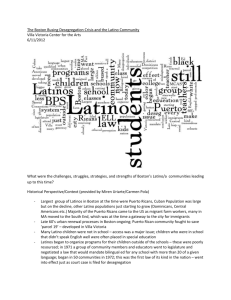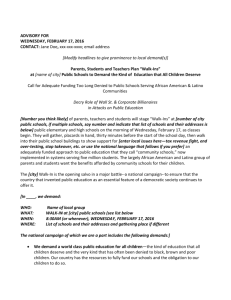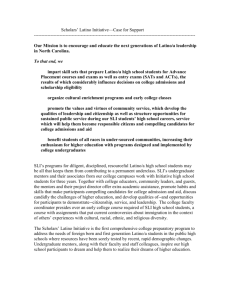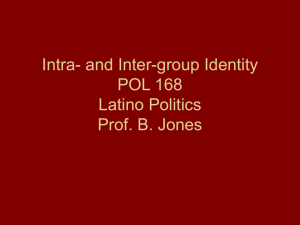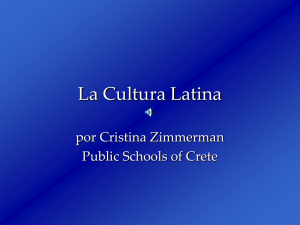File
advertisement
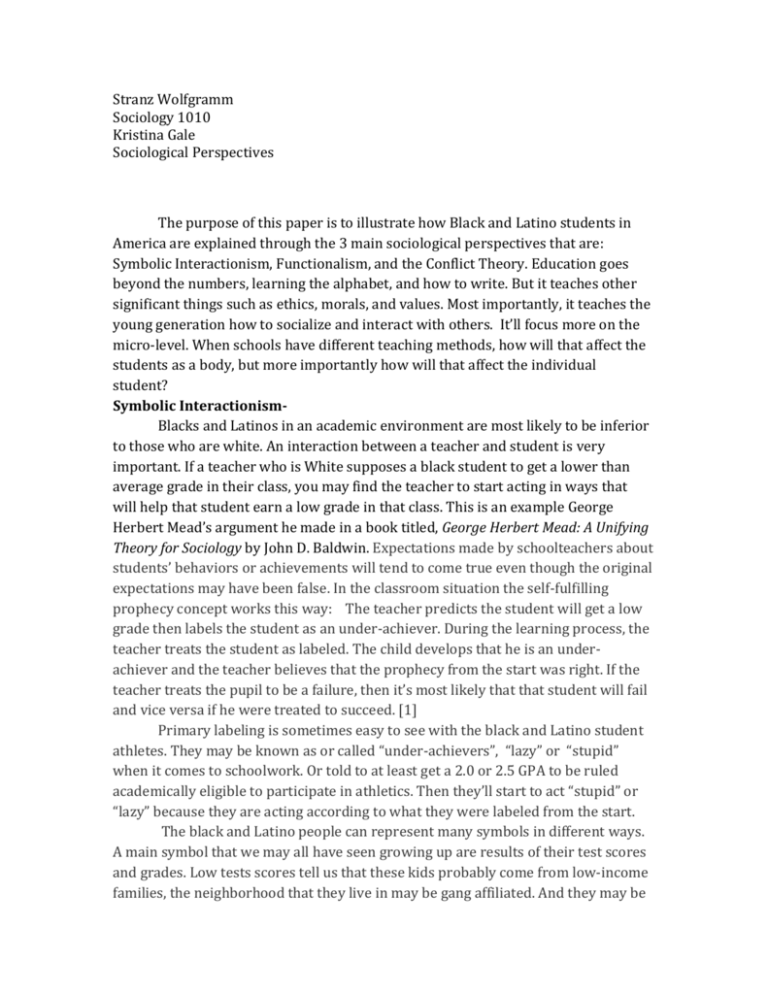
Stranz Wolfgramm Sociology 1010 Kristina Gale Sociological Perspectives The purpose of this paper is to illustrate how Black and Latino students in America are explained through the 3 main sociological perspectives that are: Symbolic Interactionism, Functionalism, and the Conflict Theory. Education goes beyond the numbers, learning the alphabet, and how to write. But it teaches other significant things such as ethics, morals, and values. Most importantly, it teaches the young generation how to socialize and interact with others. It’ll focus more on the micro-level. When schools have different teaching methods, how will that affect the students as a body, but more importantly how will that affect the individual student? Symbolic InteractionismBlacks and Latinos in an academic environment are most likely to be inferior to those who are white. An interaction between a teacher and student is very important. If a teacher who is White supposes a black student to get a lower than average grade in their class, you may find the teacher to start acting in ways that will help that student earn a low grade in that class. This is an example George Herbert Mead’s argument he made in a book titled, George Herbert Mead: A Unifying Theory for Sociology by John D. Baldwin. Expectations made by schoolteachers about students’ behaviors or achievements will tend to come true even though the original expectations may have been false. In the classroom situation the self-fulfilling prophecy concept works this way: The teacher predicts the student will get a low grade then labels the student as an under-achiever. During the learning process, the teacher treats the student as labeled. The child develops that he is an underachiever and the teacher believes that the prophecy from the start was right. If the teacher treats the pupil to be a failure, then it’s most likely that that student will fail and vice versa if he were treated to succeed. [1] Primary labeling is sometimes easy to see with the black and Latino student athletes. They may be known as or called “under-achievers”, “lazy” or “stupid” when it comes to schoolwork. Or told to at least get a 2.0 or 2.5 GPA to be ruled academically eligible to participate in athletics. Then they’ll start to act “stupid” or “lazy” because they are acting according to what they were labeled from the start. The black and Latino people can represent many symbols in different ways. A main symbol that we may all have seen growing up are results of their test scores and grades. Low tests scores tell us that these kids probably come from low-income families, the neighborhood that they live in may be gang affiliated. And they may be raised in a household where “just getting by” is okay. That the importance of education or to prepare for the long run is not emphasized. FunctionalismA classic study by sociologist James Coleman done in 1966, known as the “Coleman Report” looked at the performance of over 150,000 students and found that student background and socioeconomic status were much more important in determining educational outcomes than were differences in school resources, such as per pupil spending. He also found that socially disadvantaged black students benefited and did better in school when they were in racially mixed classrooms rather than black only classrooms. [2] Unintended negative consequences that many of these black and Latino students face is the environment they grow up in. They live in lower class environments that they were born into. They couldn’t control the outcome of their beginning. Being raised in a family where education is not important. So they didn’t form those habits of working hard academically to prepare for a better future because they were never taught from an early age. In New York City, the nation’s largest school system, on average student outcomes and their opportunity to learn are more determined by the neighborhood where a child lives, than his or her abilities. Karl Marx believes that educational achievement is greatly influenced by an individual’s social class background. With this being said, we can see that education channels ruling class ideology. “An example of “Positivistism” would be ‘The Black Report’, which after research concluded that members of the working class had a greater chance of dying earlier when compared to the middle and upper classes.” [3] Conflict TheoryA new Schott Foundation for Public Education report, “A Rotting Apple: Education Redlining in New York City,” reveals that the communities where most of the city’s poor, black and Hispanic students live suffer from New York policies and practices that give their schools the fewest resources and their students the least experienced teachers. In contrast, the best-funded schools with the highest percentage of experienced teachers are most often located in the most economically advantaged neighborhoods. [4] By the end of high school, in fact, African American and Latino students have abilities in both mathematics and reading that are the same as those of white students in 8th grade. In the 18 to 24 year old group, about 90 percent of whites and 94 percent of Asians have either completed high school or earned a GED. Among African Americans, the rare drops to 81 percent among Latinos, 63 percent. Approximately 76 percent of white graduates and 86 percent of Asian graduates go directly to college, compared to 71 percent of African American and 71 percent of Latino graduates. Young African Americans are only about half as likely as white students to earn a bachelor’s degree by age 29; young Latinos are only one-third as likely as whites to earn a college degree [5] The Conflict Theory best fits the topic on how Blacks and Latino students are seen through the 3 main sociological perspectives. As we can see from the facts shown, there exist much inequality for not only the students, but mainly for the schools they’re being educated at. It’s clear that Black and Latino are the ones in conflict, and the results will stay the same if the flaws in the educational system are not corrected. From an adult’s viewpoint, they make comments like, “Their parents don’t care” or “they’re too poor.” From a student’s viewpoint, they may say, “their teachers are not qualified to teach the subject their assigned.” My cousin’s friend who’s from Chicago felt the same about his teachers. He said, “The teachers were never motivating at all, they’d give us assignment after assignment with a lot of times no explanation on how to do the assignment.” He continues, “I would go my counselor(s) who I thought would help me, but they underestimated my potential and placed me in lower-level courses.” [6] One of the major problems is that many school systems are taking those who already have less than others and putting them in educational programs that give them less. We can see this through both research and many of us may have experienced seen this first hand, but what schools do matter greatly in the outcome of an individual. “To increase the achievement levels of minority and low-income students, we need to focus on what really matters: high standards, a challenging curriculum, and good teachers.” [7] Work Cited [2] Angrist, J. D., & Kevin, L. (2004). Does school integration generate peer effects? Evidence from Boston's Metco Program. American Economic Review, 94(5), 1613-1634. Retrieved November 11, 2012 [1] Baldwin, J. D. (2004). George Herbert Mead: A Unifying Theory of Sociology. N.p.: Kendall Hunt. Retrieved November 12, 2012 [3] Bryant, L. (n.d.). Functionalism and Education. In History Learning Site. Retrieved November 14, 2012, from http://www.historylearningsite.co.uk/functionalsim_education.htm [4] Jackson, D. H., & Noguera, D. (2011). Why Education Inequality Persist- And How To Fix It. The Washing Post. Retrieved November 16, 2012, from http://schottfoundation.org/drupal/media-center/why-education-inequalitypersists-and-how-to-fix-it [7] Haycock, K. (2006). HELPING ALL STUDENTS ACHIEVE: CLOSING THE ACHIEVEMENT GAP. In Center for Development and Learning. Retrieved November 17, 2012, from http://www.cdl.org/resourcelibrary/articles/achieve_gap.php [5] U.S. Census Bureau. (1998). Educational Attainment Detailed Tables, October CPS. Retrieved November 13, 2012 from, http://www.cdl.org/resource-library/articles/achieve_gap.php [6] Interview of Akol Stevens. Retrieved November 4, 2012. Salt Lake City, UT.



